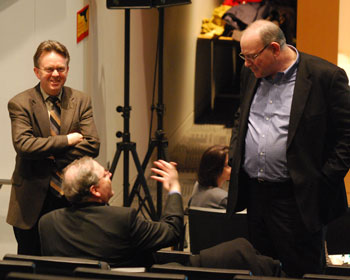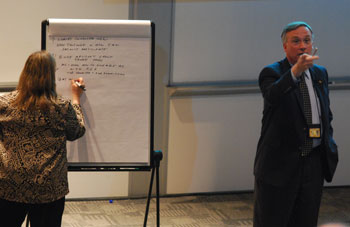UM Makes Plans for Pfizer Research Campus

Jim Bell, center, chief administrative officer for the UM Medical School, chats with Marvin Parnes, right, associate vice president for research and executive director of research administration, and John Ballew, director of UM Health System facilities planning. They were awaiting the start of Tuesday's forum on possible uses for the Pfizer research campus.
Jim Woolliscroft was Harlan Hatcher’s personal physician, and near the end of the former University of Michigan president’s life, Woolliscroft made house calls to check in on him. That gave them time to talk. And one of the things they talked about was UM’s purchase of the property that became North Campus.
Hatcher told Woolliscroft that when UM leaders decided to buy the 800 acres of farmland north of Ann Arbor, they didn’t know exactly how they’d use it – but they knew it would transform the university.
Woolliscroft, dean of the UM Medical School, told that anecdote Tuesday afternoon to the 100 or so people gathered at a forum on the future of the Pfizer research campus, which UM is in the process of acquiring. This purchase isn’t quite as bold as the one made in the early 1950s, Woolliscroft said, but its potential to transform in unimaginable ways is great: “That opportunity is phenomenal.”
The forum was one of three held this year for faculty to talk about how the university will use the former Pfizer facility. Tuesday’s hour-long session focused on process, with administrators outlining just how they’ll go about deciding what academic research or other activities are located at the site.
There’s a lot of space to fill. The 174-acre piece of land, located off of Plymouth Road near UM’s North Campus, contains 30 buildings with just over 2 million square feet of space, including research wet labs and offices. The site also includes a pharmaceutical manufacturing building that’s fairly new, and a cafeteria that seats 800 people.
To cover the $108 million purchase price, the Medical School is paying $62 million, with UM Hospitals and Health Centers (HHC) picking up $15 million and $31 million coming from central administration. By comparison, the Medical School and HHC paid $245 million to build the Biomedical Science Research Building, known as the BSRB – a 435,00-square-foot structure that opened three years ago. Woolliscroft said the medical school had projected that its space needs by 2020 would require an amount of square footage equivalent to what was now available at the Pfizer site. Given that fact, plus the cost comparison with the BSRB, Woolliscroft said the Pfizer purchase made sense.
Woolliscroft expects the deal to be completed by June of this year – right now, the university is conducting due diligence before closing the deal, he said.
Meanwhile, Woolliscroft said that faculty and administrators need to think about how to organize their research and educational efforts, imagining new ways to do things that in the past weren’t possible because they didn’t have the space. Several committees are being pulled together to work on different aspects of this massive effort. Among them are:
- An external advisory group composed of scientists outside the university who will “hold our collective feet to the fire,” Woolliscroft said. They’ll be asked to provide scientific advice and direction, and will likely meet for the first time in September.
- A committee on facilities planning and logistics to coordinate due diligence efforts and prepare for things like security needs, lease consolidation and the operation of a power plant on the site.
- A group – led by UM professor and entrepreneur Jim Baker and associate vice president for research Marvin Parnes – to look at public/private partnerships. That could include designated space for start-up companies founded by UM faculty as well as incubator space for fledgling businesses.
- A committee to communicate the progress of these and other efforts. A key component of that will be the UM Research Growth website, Woolliscroft said, which will be updated as new information is available. He expects more activity on this front after the deal is completed – for now, they’re somewhat “muzzled” by the confidentiality agreement with Pfizer, he said.
Committees are also being formed to explore interdisciplinary collaboration in the areas of neurosciences, health sciences and drug discovery. Other areas are being identified, Woolliscroft said, and might include imaging, nanotechnology and cancer research, among others.
Before taking questions, Woolliscroft handed the presentation over to Steve Kunkel, the Medical School’s senior associate dean for research. Kunkel said they’ve been working for months to develop a research strategic plan related to this expansion, and he outlined some of the steps they’d taken. There are three tiers in their approach, he said: 1) Look for obvious strengths, 2) Find ways to leverage existing strengths into new areas, and 3) Develop “revolutionary” new areas of research – the most important goal, but also the most difficult, he said.

An assistant takes notes while Jim Woolliscroft, dean of the UM Medical School, fields a question from the audience at Tuesday's forum, held at the Chrysler Center on North Campus.
Following the main presentation, several people in the audience had questions for Woolliscroft. Ken Nisbet, executive director of UM’s Office of Technology Transfer, asked what the process and criteria were for deciding who moves into the Pfizer site. Woolliscroft said that some physician-scientists will locate their labs in the closest physical proximity to where they practice. In other cases, labs are dependent on samples that emanate from clinics, and again need to be close to that source. The roles that faculty play will be a factor in deciding where to locate their work.
An administrator from the College of Engineering asked what the financial arrangements would be if engineering faculty wanted to use some of the Pfizer space. Woolliscroft said that to pay for the Medical School’s part of the acquisition, they’d be collecting about $7,000 per year from each of their faculty members over the next 10 years – the school has over 2,000 faculty. He said as other groups came in, they’d expect to work out an appropriate investment. Woolliscroft noted that each of UM’s colleges or schools is funded differently. The Medical School is self-funded, and charges its faculty for the space they use for offices and labs – roughly $43 per square foot for wet lab space, and about half that for office space, he said.
Someone from the audience asked whether the efforts at public/private partnerships would include the availability of specialized space, or a true incubator with support services. Both, Woolliscroft said. He added that there’s been a paucity of wet lab space available for startups in this area. “Now,” he said, “we’ve got it.”
One woman asked whether the slides shown at this presentation, which were quite detailed, would be posted on the Research Growth website. Not yet, Woolliscroft said. Though there’s nothing on the slides that violates their confidentiality agreement with Pfizer, they weren’t going to post that information until UM’s top administrators gave the go-ahead. [The Chronicle has put in a request for the slides, and will post them here when they are released.]
Another person said there’d been issues related to the integration of Central Campus and North Campus, and he wondered what the challenges would be to integrating yet another area – the Northeast Campus – into the rest of the university, and how they planned to address those challenges.
Transportation would be key, Woolliscroft said. One possibility would be to have a fleet of small buses that run regularly between the campuses, he said. But in his wildest dreams, he added, he envisioned a monorail or something akin to the People Mover, which would run from the south athletic campus all the way to the university’s north side. Other opportunities to draw people to the former Pfizer site would include the day care center there as well as the large cafeteria – figuring out how to do food service there is one of their tasks. “I don’t know all the answers,” he said.




Thanks for the in-depth article. I am especially interested in how they are going to handle the transportation question. The UM has a great opportunity to encourage a large amount of people to look at using sustainable transportation as they look to purchase the Pfizer site. It’s often easier to get someone to look at alternatives when they are first starting a job, moving, etc. I hope the UM continues to look at how they can encourage the employees at this site to seek other forms of transportation rather that the single occupancy auto.
I also hope that the increased amount of people in this area will make something like a monorail viable. That sort of service could benefit a whole lot of people.
There’s a typo in the article:
“By comparison, the Medical School and HHC paid $245 million to build the Biomedical Science Research Building, known as the BSRB – a 435,00-square-foot structure that opened three years ago.”
That’s 435,000 square feet or 472,000 gross square feet according to link.
It would be good to know more about the current state of progress on the City’s transportation plan, which identified the Northeast route from Central to North Campus and Plymouth, currently served by the AATA’s #2 bus, as the top opportunity for bringing high-capacity rapid transit (probably either bus rapid transit or streetcars) to Ann Arbor’s transit system. That would vastly benefit the U, City, and the efforts of both towards sustainability. Perhaps the Chronicle could investigate?
With all due respect to Woolliscroft, the idea of a “monorail” is vintage 1960. Streetcars, bus rapid transit, and light rail constitute the contemporary menu of enhanced local transit service.
I think that a personal rapid transit (PRT) system like the JPods concept (www.jpods.com) would be well worth exploring. It has the highest potential for true sustainability of any non-human or animal-powered vehicle system that I’m aware of. One upside in our climate is that snow clearing wouldn’t be necessary, whereas it would be for ground-based systems. The nature of the campus (i.e., few road crossings) might allow such a system to be put in place.
Someone once suggested a cable car system between Central and North Campus. Probably not practical, but it would be a fun ride!
If you travel Fuller Road during most times of the day, you will invariably find yourself either behind or in front of a UM bus (often 3-4 in a row) packed with students traveling between North and Central Campus. Ridership numbers that most public transportation managers only dream about.
This is a good opportunity to experiment with some of the options Joel mentions, and UM should take the lead on this. Hopefully, mass transit to and from Ann Arbor for the thousands of UM Health System workers is not far behind–instead of more parking structures.
There’s a north-south connector study to be undertaken at some point for the Plymouth-State corridor, once allocation of funding responsibilities are determined for each of the four partners: UM, DDA, city of Ann Arbor, AATA. Some previous coverage of the north-south connector study is here.
Thanks for the coverage of this topic. It really sounds like the U of M is getting a fantastic deal on the pfizer property and a huge responsibility. Most people I talk to are extremely relieved that the U of M will be redeveloping the site vs it sitting empty. I don’t believe many private companies would be able to do with the site what U of M has the potential to do.